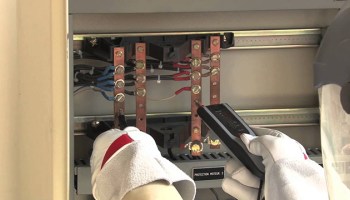Basic criteria for electrical safety
The assessment of the level of electrical safety during the operation and repair of electrical equipment is possible on the basis of comparing the calculated currents through the human body with the permissible ones. The duration of exposure and the value of the current are the main parameters on which the outcome of the injury depends. They are therefore electrical safety criteria.

Protective measures and means against electric shock must be calculated and created taking into account the values of the currents permissible for a person for a given duration and the path of its passage through the body or the touch voltages corresponding to these currents (Upr = Ih • Rh).
The main criteria for electrical safety are the threshold values of electric current corresponding to the reactions of the human body, they are necessary for the calculation of protective measures and means in electrical installations.
GOST 12.1.038-88 SSBT establishes standards for the maximum permissible values of contact voltages and currents, applicable to industrial and household electrical installations of direct and alternating current with a frequency of 50 and 400 Hz and corresponding to the passage of the current along a "hand-to-hand" path » or «hand-to-foot»... The norms are provided for the normal (non-emergency) operation of electrical installations and emergency operation.
Touch voltages and currents flowing through the human body during normal (emergency) operation of the electrical installation should not exceed the values given in the table.
Current U, B I, mA Variable, 50 Hz 2 0.3 Variable, 400 Hz 3 0.4 Constant 8 1.0
Touch voltages and currents are given for an exposure duration of no more than 10 minutes per day and are set based on the sensation response.
Touch voltages and currents for persons performing work under conditions of high temperature (over 25℃) and humidity (relative humidity over 75%) should be reduced three times.
For domestic electrical installations with a voltage of up to 1000 V and a frequency of 50 Hz in emergency modes, the maximum permissible values of contact voltage and currents, depending on the exposure time, are given in the table.
Domestic electrical installations are electrical installations that are used in residential, municipal and public buildings of any type, with which both adults and children can interact.
T(sec) 0.01 — 0.08 0.1 0.2 0.3 0.4 0.5 0.6 0.7 0.8 0.9 1
Vpr (B)
220 200 100 70 55 40 35 30 27 25 12
For industrial electrical installations with a voltage over 1000 V with solid grounding of the neutral and a frequency of 50 Hz in emergency modes, the maximum permissible values of touch voltages, depending on the exposure time, must not exceed the specified mass values.
T(sec) 0.01 0.2 0.5 0.7 1 from 1 to 5
Vpr (B)
500 400 200 130 100 65
